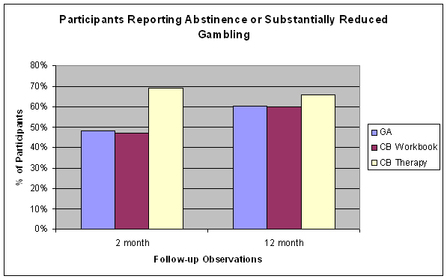The WAGER Vol. 11(9) – Three different paths to improvement; but, is there a difference?
Pathological gambling (PG) is associated with significant negative financial, psychosocial and health consequences (Petry, Ammerman, Bohl, Doersch, Gay, Kadden, Molina, & Steinberg, 2006). Current research estimates the prevalence of lifetime PG to be about 1.5% among U.S. adults (Shaffer, Hall, & Vander Bilt, 1999). Despite the prevalence and associated sequelae of gambling disorders, little is known about the effectiveness of current treatments for PG (Petry et al., 2006). This week’s WAGER reviews a study that evaluates the relative efficacy of three interventions for reducing gambling among treatment-seeking pathological gamblers.
Petry et al. (2006) recruited pathological gamblers (N=231) using media announcements between 1998 and 2002. The inclusion criteria for participants were: 18 years of age and older, a diagnosis of pathological gambling (DSM-IV), had gambled during the past 2 months, and could read at a 5th grade level. Participants were randomized into three groups: (a) referral to Gamblers Anonymous (GA) (n=63), (b) GA referral plus a cognitive-behavioral (CB) workbook (n=84), or (c) GA referral plus 8 sessions of individual CB therapy (n=84). Gambling and related problems were assessed at baseline, 1-month (i.e., during treatment), 2-months (i.e., post-treatment), and at 6 and 12-month follow-ups. Researchers used a module adapted from the Structured Clinical Interview for Pathological Gambling (SCIPG) (Grant, Steinberg, Kim, Rounsaville, & Potenza, 2004) to assess pathological gambling, the South Oaks Gambling Survey (SOGS) to assess gambling problems at baseline and throughout follow-up, the Addiction Severity Index (ASI) to assess other addictive disorders, and the timeline follow-back method to assess frequency and intensity of past gambling behaviors. Investigators used analysis of variance and chi-square procedures to test for statistical significance of differences across the three treatment groups.
Researchers found statistically significant differences between GA and both CB conditions at 1-month and 2-months after baseline. They reported significant improvement in number of days gambled, number of consecutive non-heavy gambling days (<$5/day), SOGS scores, and abstinence for those in the CB conditions when compared to the GA referral condition. However, at 12 months, there was no significant difference between conditions in the proportions of participants who abstained, substantially reduced, somewhat reduced, or had no change in their gambling behavior (.2 (6) = 6.25, p = .39, N=178) (See Figure 1). Furthermore, at the 12-month follow-up the percentages of participants classified as abstinent or having substantially reduced gambling were 60.5%, 60.0%, and 65.7% in GA referral, CB workbook, and CB therapy conditions, respectively (see Figure 1). The relatively high levels of success obtained regardless of treatment modality are impressive, considering that 41.3% of participants in the GA condition never attended any GA meetings and 28.9 % of participants in the CB workbook condition never completed any chapters.
Figure 1. Participants Reporting Abstinence or Substantially Reduced Gambling
* TLFB data for 6-month followup was unavailable.
*GA = Gamber’s Anonymous; CB = Cognitive Behavioral
The findings of this paper support the idea that gambling disorders are dynamic and, therefore, change without regard to type of treatment (including natural recovery). This change could be caused by either the treatments themselves or other factors (e.g., people simply stopping, running out of money, or being incarcerated). Though certain therapies might have immediate short-term effects, there currently is little evidence that the long-term effects differ between GA, individual therapy, or natural recovery.
One limitation of this study is that the number of sessions was not the same across all therapy groups; therefore, any observed differences between groups might have been due to frequency of involvement and not to the type of therapy. Furthermore, these findings are only generalizable to pathological gamblers who present for treatment and not all pathological gamblers, thereby limiting these results to only a portion of this population.
Despite the limitations and negligible long-term differences among conditions, the findings of this study are important. The research suggests that intensive therapy can have immediate positive effects, but that those effects diminish over time. It also suggests that disordered gamblers can significantly improve their behavior with minimal intervention. In terms of developing effective treatments, this study suggests that developing brief interventions for gambling disorders might be a cost-effective treatment strategy. More clinical trials are necessary to evaluate this issue.
What do you think? Comments on this article can be addressed to Juan Molina.
References
Grant, J.E., Steinberg, M.A., Kim, S.W., Rounsaville, B.J., & Potenza, M.N. (2004). Preliminary validity and reliability testing of a structured clinical interview for pathological gambling. Psychiatry Research, 128, 79-88.
Petry, N.M., Ammerman, Y., Bohl, J., Doersch, A., Gay, H., Kadden, R., Molina, C., & Steinberg, K. (2006). Cognitive-Behavioral Therapy for Pathological Gamblers. Journal of Consulting and Clinical Psychology, 74(3), 555-567.
Shaffer, H.J., Hall, M.N., & Vander Bilt, J. (1999). Estimating the prevalence of disordered gambling behavior in the United States and Canada: A research synthesis. American Journal of Public Health, 89(9), 1369-1376.
Shaffer, H.J., LaBrie, R.A., & LaPlante, D.A. (2004). Laying the Foundation for Quantifying Regional Exposure to Social Phenomena: Considering the Case of Legalized Gambling as a Public Health Toxin. Psychology of Addictive Behaviors, 18(1), 40–48.
